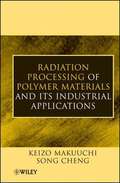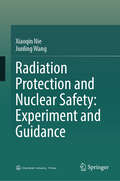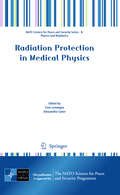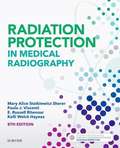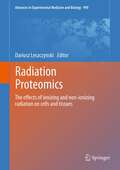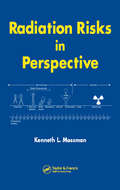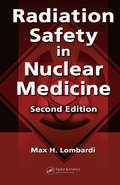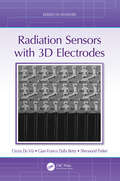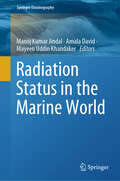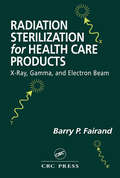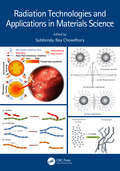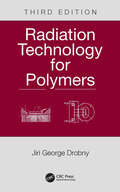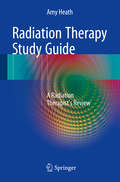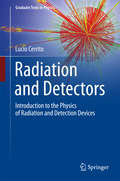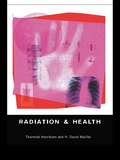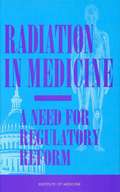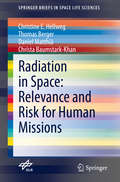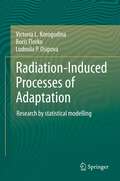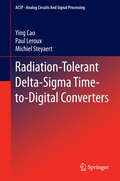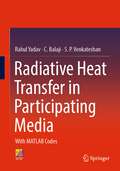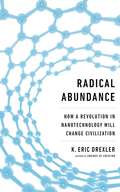- Table View
- List View
Radiation Processing of Polymer Materials and Its Industrial Applications
by Song Cheng Keizo MakuuchiUp-to-date, comprehensive coverage on radiation-processed polymer materials and their applicationsOffering a unique perspective of the industrial and commercial applications of the radiation processing of polymers, this insightful reference examines the fundamental scientific principles and cutting-edge developments advancing this diverse field. Through a variety of case studies, detailed examples, and economic feasibility analysis, Radiation Processing of Polymer Materials and Its Industrial Applications systematically explains the commercially viable ways to process and use radiation-processed polymeric materials in industrial products. In addition, this one-of-kind text:Covers important chemistry and processing fundamentals, while emphasizing their translation into practical applications of radiation-processed polymersIncorporates new applications in nanotechnology, biomaterials, and recyclingSystematically discusses new developments in the field and summarizes past achievementsBy helping readers--from students to scientists, engineers, technicians, and sales and marketing professionals--understand and solve problems associated with radiation processing of polymers, Radiation Processing of Polymer Materials and Its Industrial Applications serves as an essential reference and fills an important gap in the literature.
Radiation Protection
by William H. HallenbeckThis text/reference provides an excellent introduction to fundamental topics in radiation protection, including energetics, kinetics, interaction, external radiation protection, dosimetry, standards, and measurement. Chapters on radioactive waste and radon, topics not normally covered in introductory texts, have been incorporated as well. An extensive glossary of terms, abbreviations, acronyms, physical constants, units, and unit conversions provides a ready source of frequently needed information. Several appendices contain specifications and vendors for commercially available portable radiation survey instruments, personal dosimeters, and radon/radon progeny monitors.
Radiation Protection and Nuclear Safety: Experiment and Guidance
by Junling Wang Xiaoqin NieThis book reviews the theory and practice on radiation protection and nuclear safety based on experimental case studies. It concentrates on research advances in radiation detection, radiation monitoring, radioactive waste treatment and disposal. It can both serve as a textbook for advanced undergraduates majoring in radiation protection and nuclear safety, nuclear engineering and technology, nuclear chemical engineering and nuclear fuel engineering and a reference for industry and institutes. The basis of English translation of this book, originally in Chinese, was facilitated by artificial intelligence. The content was later revised by the author for accuracy.
Radiation Protection at Light Water Reactors
by Robert PrinceThis book is aimed at Health Physicists wishing to gain a better understanding of the principles and practices associated with a light water reactor (LWR) radiation protection program. The role of key program elements is presented in sufficient detail to assist practicing radiation protection professionals in improving and strengthening their current program. Details related to daily operation and discipline areas vital to maintaining an effective LWR radiation protection program are presented. Programmatic areas and functions important in preventing, responding to, and minimizing radiological incidents and the importance of performing effective incident evaluations and investigations are described. Elements that are integral in ensuring continuous program improvements are emphasized throughout the text.
Radiation Protection in Medical Physics
by Yves Lemoigne Alessandra CanerThis book introduces the fundamental aspects of Radiation Protection in Medical Physics and covers three main themes: General Radiation Protection Principles; Radiobiology Principles; Radiation Protection in Hospital Medical Physics. Each of these topics is developed by analysing the underlying physics principles and their implementation, quality and safety aspects, clinical performance and recent advances in the field. Some issues specific to the individual techniques are also treated, e.g. calculation of patient dose as well as that of workers in hospital, optimisation of equipment used, shielding design of radiation facilities, radiation in oncology such as use of brachytherapy in gynecology or interventional procedures. All topics are presented with didactical language and style, making this book an appropriate reference for students and professionals seeking a comprehensive introduction to the field as well as a reliable overview of the most recent developments.
Radiation Protection in Medical Radiography
by Mary Alice Statkiewicz Sherer Paula J. Visconti E. Russell Ritenour Kelli Welch HaynesGain a full understanding of both basic and complex concepts in radiation protection, biology, and physics. <p><p> Beautifully designed and easy to follow, Radiation Protection in Medical Radiography, 8th Edition promotes the safe use of ionizing radiation in all imaging modalities, including the effects of radiation on humans at the cellular and systemic levels, regulatory and advisory limits for human exposure to radiation, and the implementation of radiation safety practices for patients and personnel. <p><p> This market-leading text reflects the latest ARRT and ASRT curriculum guidelines to help you succeed on the ARRT exam. Plus, the new edition includes tables with sensitivity ranges to provide easy reference for each type of dosimeter.
Radiation Proteomics
by Dariusz LeszczynskiMethods of proteomics have been shown to be powerful tools in search of target proteins - proteins that respond in cells to an internal or an external stimulus. Proteomics is widely used in biomedical research. However, in radiation biology research, following exposures of living matter to low doses of either ionizing or non-ionizing radiation, proteomics approach is only very slowly gaining support. This book, by presenting the current status of the use of proteomics in radiation biology, will help to attract attention to the field of radiation proteomics.
Radiation Risks in Perspective
by Kenneth L. MossmanPublic misperception of radiological risk consistently directs limited resources toward managing minimal or even phantom risks at great cost to government and industry with no measurable benefit to overall public health. The public's inability to comprehend small theoretical risks arrived at through inherently uncertain formulae, coupled with an ir
Radiation Safety in Nuclear Medicine
by Max H. Lombardi Allen Cato III Lynda SuttonRecent advances in the field of nuclear medicine (NM) are expanding the role and responsibilities of the nuclear medicine technologist (NMT) to include more complex and detailed tasks. New technologies are making the diagnosis, management, and treatment of illnesses more sensitive, more specific, more accurate, and ultimately safer for both the pat
Radiation Sensors with 3D Electrodes (Series in Sensors)
by Sherwood Parker Cinzia Da Vià Gian-Franco Dalla BettaWritten by the leading names in this field, this book introduces the technical properties, design and fabrication details, measurement results, and applications of three-dimensional silicon radiation sensors. Such devices are currently used in the ATLAS experiment at the European Centre for Particle Physics (CERN) for particle tracking in high energy physics. These sensors are the radiation hardest devices ever fabricated and have applications in ground-breaking research in neutron detection, medical dosimetry and space technologies and more. Chapters explore the essential features of silicon particle detectors, interactions of radiation with matter, radiation damage effects, and micro-fabrication, in addition to a providing historical overview of the field. This book will be a key reference for students and researchers working with sensor technologies. Features: The first book dedicated to this unique and growing subject area, which is also widely applicable in high-energy physics, medical physics, space science and beyond Authored by Sherwood Parker, the inventor of the concept of 3D detectors; Cinzia Da Vià, who has brought 3DSi technology to application; and Gian-Franco Dalla Betta, a leading figure in the design and fabrication technology of these devices Explains to non-experts the essential features of silicon particle detectors, interactions of radiation with matter, radiation damage effects, and micro-fabrication
Radiation Status in the Marine World (Springer Oceanography)
by Manoj Kumar Jindal Amala David Mayeen Uddin KhandakerNatural radiation is omnipresent everywhere on the earth, and humans cannot avoid it. Natural radiation is a critical aspect in understanding the health issue and predicting the existence of radionuclides. Because the ocean is the source of all materials, and due to the fact that water from everywhere is submerged in the ocean through river networks, the ocean will contain varying radiation doses in every site. This book has information about radiation status near the ocean in all areas on Earth. There are five oceans, namely: the Atlantic, Pacific, Indian, Arctic, and Antarctic Oceans. This book is a valuable resource of its kind for indicating the radiation status in all types of oceans. The outcomes of this book are extremely valuable to people in a variety of fields, including health sciences, material sciences, radiological fields, environmental science, oceanology, water world, and so on.
Radiation Sterilization for Health Care Products: X-Ray, Gamma, and Electron Beam
by Barry P. FairandFocusing on how the radiation process works and how it is applied in sterilizing medical devices and healthcare products, Radiation Sterilization for Health Care Products covers recent developments in radiation technology such as e-beams, gamma rays, and x-rays. The author discusses the design and operation of irradiators as well as factors that affect cost and efficiency. He offers readers practical insights on this critical step in healthcare product manufacturing, its current uses, and its related cost concerns. Authortitative and comprehensive, the book brings togehter information scattered throughout the literature into one convenient resource.
Radiation Synthesis of Materials and Compounds
by Boris I. Kharisov Oxana V. Kharissova Ubaldo Ortiz MéndezResearchers and engineers working in nuclear laboratories, nuclear electric plants, and elsewhere in the radiochemical industries need a comprehensive handbook describing all possible radiation-chemistry interactions between irradiation and materials, the preparation of materials under distinct radiation types, the possibility of damage of material
Radiation Technologies and Applications in Materials Science
by Subhendu Ray ChowdhuryThis book explains various kinds of non-ionizing and high-energy radiations, their interaction with materials and chemical reactions, and conditions of various kinds of materials development technologies including applications. It covers a processing-structure-property relationship and radiations used in developing many advanced materials used in various fields. It highlights application-oriented materials synthesis and modification covering a wide variety of materials such as plastics, rubber, thermo-set, ceramics, and so forth by various radiations. Features: Explains ionizing and non-ionizing radiation-assisted materials development technologies, for polymers, ceramics, metals, and carbons. Covers radiation-assisted synthesis, processing, and modification of all kinds of materials. Provides comparative studies, merits, demerits, and applications very systematically. Criss-crosses polymers science and technology, radiation technology, advanced materials technology, biomaterials technology, and so forth. Includes a section on 3D printing by LASER melting of CoCr alloys. This book is aimed at researchers and graduate students in materials science, radiation chemistry and physics, and polymer and other materials processing.
Radiation Technology for Polymers
by Jiri George DrobnyThis practical book sets the standard as a valuable, time-saving resource offering systematic fundamental information about industrial radiation technologies. This new edition explores updates to emerging applications of ultraviolet (UV) and electron beam (EB) radiation to polymer processing and offers updates throughout to detail changes changes, new trends, and general issues in radiation technology. It presents vital, cutting-edge information to aid further reduction of volatile organic compounds and toxic substances in the environment, develop alternative sources of energy, and harness energy in both medical and industrial applications. New features of this edition include: Stresses the practical aspects of UV/EB technology and its industrial application Includes updates on UV radiation processes and applications of UV radiation Explores new engineering data of selected commercial products Written by an expert with over forty years of experience, this book would make an excellent resource for scientists and engineers in the fields of materials science and polymer chemistry.
Radiation Therapy Study Guide
by Amy HeathThis book is a comprehensive review and study aid for radiation therapists. Organized in a question-and-answer format, it present clinical features and principles of treatment. Topics include radiation therapy physics, radiobiology, treatment and simulation equipment, principles of patient care, clinical components of cancer care, and cancers of the brain, head and neck region, and respiratory, digestive, urinary, and male and female reproductive systems. It offers over 500 multiple-choice questions with detailed answers and rationales. Radiation Therapy Study Guide is a valuable resource for radiation therapists preparing for certification examinations as well as for practicing therapists in need of a review.
Radiation Transfer
by L. A. Apresyan Yu. A KravtsovThe authors expound on non-traditional phenomena for transfer theory, which are nevertheless of considerable interest in wave measurements, and bring the advances of transfer theory as close as possible to the practical needs of those working in all areas of wave physics. The book opens with a historical overview of the topic, then moves on to examine the phenomenological theory of radiative transport, blending traditional theory with original ideas. The transport equation is derived from first principles, and the ensuing discussion of the diffraction content of the transport equation and non-classical radiometry is illustrated by practical examples from various fields of physics. Popular techniques of solving the transport equation are discussed, paying particular attention to wave physics and computing the coherence function. The book also examines various problems which are no longer covered by the traditional radiative transfer theory, such as enhanced backscattering and weak localization phenomena, nonlinear transport problems and kinetic equations for waves. This monograph bridges the gap between the simple power balance description in radiative transfer theory and modern coherence theory. It will be of interest to researchers and professionals working across a wide range of fields from optics, acoustics and radar theory to astrophysics, radioastronomy and remote sensing, as well as to students in these areas.
Radiation and Detectors
by Lucio CerritoThis textbook provides an introduction to radiation, the principles of interaction between radiation and matter, and the exploitation of those principles in the design of modern radiation detectors. Both radiation and detectors are given equal attention and their interplay is carefully laid out with few assumptions made about the prior knowledge of the student. Part I is dedicated to radiation, broadly interpreted in terms of energy and type, starting with an overview of particles and forces, an extended review of common natural and man-made sources of radiation, and an introduction to particle accelerators. Particular attention is paid to real life examples, which place the types of radiation and their energy in context. Dosimetry is presented from a modern, user-led point of view, and relativistic kinematics is introduced to give the basic knowledge needed to handle the more formal aspects of radiation dynamics and interaction. The explanation of the physics principles of interaction between radiation and matter is given significant space to allow a deeper understanding of the various technologies based on those principles. Following an introduction to the ionisation mechanism, detectors are introduced in Part II, grouped according to the physical principle that underpins their functionality, with chapters covering gaseous detectors, semiconductor detectors, the scintillation process and light detectors. The final two chapters describe the phenomenology of showers and the design of calorimeters, and cover additional phenomena including Cherenkov and transition radiation and the detection of neutrinos. An appendix offers the reader a useful review of statistics and probability distributions. The mathematical formalism is kept to a minimum throughout and simple derivations are presented to guide the reasoning and facilitate understanding of the working principles. The book is unique in its wide scope and introductory level, and is suitable for undergraduate and graduate students in physics and engineering. The reader will acquire an awareness of how radiation and its exploitation are becoming increasingly relevant in the modern world, with over 140 experimental figures, detector schematics and photographs helping to relate the material to a broader research context.
Radiation and Health
by Thormod Henriksen David H. MaillieRadiation and the effects of radioactivity have been known for more than 100 years. International research spanning this period has yielded a great deal of information about radiation and its biological effects and this activity has resulted in the discovery of many applications in medicine and industry including cancer therapy, medical diagnostics
Radiation in Medicine: A Need for Regulatory Reform
by Gary Penn Kate-Louise D. GottfriedDoes radiation medicine need more regulation or simply better-coordinated regulation? This book addresses this and other questions of critical importance to public health and safety. The issues involved are high on the nation's agenda: the impact of radiation on public safety, the balance between federal and state authority, and the cost-benefit ratio of regulation. Although incidents of misadministration are rare, a case in Pennsylvania resulting in the death of a patient and the inadvertent exposure of others to a high dose of radiation drew attention to issues concerning the regulation of ionizing radiation in medicine and the need to examine current regulatory practices. Written at the request from the Nuclear Regulatory Commission (NRC), Radiation in Medicine reviews the regulation of ionizing radiation in medicine, focusing on the NRC's Medical Use Program, which governs the use of reactor-generated byproduct materials. The committee recommends immediate action on enforcement and provides longer term proposals for reform of the regulatory system. The volume covers Sources of radiation and their use in medicine. Levels of risk to patients, workers, and the public. Current roles of the Nuclear Regulatory Commission, other federal agencies, and states. Criticisms from the regulated community. The committee explores alternative regulatory structures for radiation medicine and explains the rationale for the option it recommends in this volume. Based on extensive research, input from the regulated community, and the collaborative efforts of experts from a range of disciplines, Radiation in Medicine will be an important resource for federal and state policymakers and regulators, health professionals involved in radiation treatment, developers and producers of radiation equipment, insurance providers, and concerned laypersons.
Radiation in Space: Relevance and Risk for Human Missions (SpringerBriefs in Space Life Sciences)
by Thomas Berger Christine E. Hellweg Daniel Matthiä Christa Baumstark-KhanThis volume of the series Springer Briefs in Space Life Sciences explains the physics and biology of radiation in space, defines various forms of cosmic radiation and their dosimetry, and presents a range of exposure scenarios. It also discusses the effects of radiation on human health and describes the molecular mechanisms of heavy charged particles’ deleterious effects in the body. Lastly, it discusses countermeasures and addresses the vital question: Are we ready for launch? Written for researchers in the space life sciences and space biomedicine, and for master’s students in biology, physics, and medicine, the book will also benefit all non-experts endeavouring to understand and enter space.
Radiation-Induced Processes of Adaptation: Research by statistical modelling
by Victoria L. Korogodina Ludmila P. Osipova Boris FlorkoIn recent decades radiobiologists' efforts have been directed at identifying the mechanisms of radiation effects; the general mechanisms have since been studied extensively. This book describes and analyzes radiation-induced adaptation as processes produced in cells, tissues, and populations. This viewpoint helps to understand the nature and factors of induced processes, to determine the characteristics of observed radiation effects and their limitations. The investigations presented here were founded on proper lab experiments, ecological studies of plant population growth near an operating nuclear power plant and a thorough epidemiological examination of human populations living in territories polluted fifty years ago, as well as on relevant published data. This research demonstrates the radiation-induced adaptation processes that continue even when the radiation itself is no longer at a critical background level. The investigations utilized the method of statistical modeling on the basis of distributions on the number of abnormalities. This method allows us to investigate the processes induced by low-dose factors when accompanied by Darwinian selection in different systems; the distribution parameters can then be used to study the characteristics of adaptation processes and system resistance. The consequences of background-level radiation continue to provoke debate, and the mathematical bases of the adaptation model are shown, while due consideration is paid to the components of adaptation: instability, selection, and proliferation. The book will be especially useful to specialists in radiation pollution, ecology, epidemiology, and radiology for studies of radiation-induced processes; the method presented here can also be adapted to investigate low-dose effects in other fields. In addition, the book presents a number of reviews in the fields of radiation biology, including pioneering investigations in Russia which were previously unavailable to Western scientists.
Radiation-Tolerant Delta-Sigma Time-to-Digital Converters
by Michiel Steyaert Ying Cao Paul LerouxThis book focuses on the design of a Mega-Gray (a standard unit of total ionizing radiation) radiation-tolerant ps-resolution time-to-digital converter (TDC) for a light detection and ranging (LIDAR) system used in a gamma-radiation environment. Several radiation-hardened-by-design (RHBD) techniques are demonstrated throughout the design of the TDC and other circuit techniques to improve the TDC's resolution in a harsh environment are also investigated. Readers can learn from scratch how to design a radiation-tolerant IC. Information regarding radiation effects, radiation-hardened design techniques and measurements are organized in such a way that readers can easily gain a thorough understanding of the topic. Readers will also learn the design theory behind the newly proposed delta-sigma TDC. Readers can quickly acquire knowledge about the design of radiation-hardened bandgap voltage references and low-jitter relaxation oscillators, which are introduced in the content from a designer's perspective. · Discusses important aspects of radiation-tolerant analog IC design, including realistic applications and radiation effects on ICs; · Demonstrates radiation-hardened-by-design techniques through a design-test-radiation assessment practice; · Describes a new type of Time-to-Digital (TDC) converter designed for radiation-tolerant application; · Explains the design and measurement of all functional blocks (e. g. , bandgap reference, relaxation oscillator) in the TDC.
Radiative Heat Transfer in Participating Media: With MATLAB Codes
by C. Balaji S. P. Venkateshan Rahul YadavThis book aims at providing a computational framework of radiative heat transfer in participating media. The book mainly helps engineers and researchers develop their own codes for radiative transfer analysis, starting from simple benchmark problems and extending further to industry scale problems. The computations related to radiative heat transfer are very relevant in iron and steel manufacturing industries, rocket exhaust designing, fire resistance testing, and atmospheric and solar applications. The methods to accurately treat the non-gray nature of the participating gases such as H2O, CO2, and CO are discussed along with considering particle radiation. The solver development based on these methods and its application to a variety of industry problems and different kind of geometries is a significant attraction in the book. The last section of the book deals with the use of artificial neural networks and genetic algorithm-based optimization technique for solving practical problems of process parameter optimization in industry. This book is a comprehensive package taking the readers from the basics of radiative heat transfer in participating media to equip them with their own solvers and help to apply to industry problems.
Radical Abundance: How a Revolution in Nanotechnology Will Change Civilization
by K. Eric DrexlerK. Eric Drexler is the founding father of nanotechnology-the science of engineering on a molecular level. In Radical Abundance, he shows how rapid scientific progress is about to change our world. Thanks to atomically precise manufacturing, we will soon have the power to produce radically more of what people want, and at a lower cost. The result will shake the very foundations of our economy and environment. Already, scientists have constructed prototypes for circuit boards built of millions of precisely arranged atoms. The advent of this kind of atomic precision promises to change the way we make things-cleanly, inexpensively, and on a global scale. It allows us to imagine a world where solar arrays cost no more than cardboard and aluminum foil, and laptops cost about the same. A provocative tour of cutting edge science and its implications by the field’s founder and master, Radical Abundance offers a mind-expanding vision of a world hurtling toward an unexpected future.
